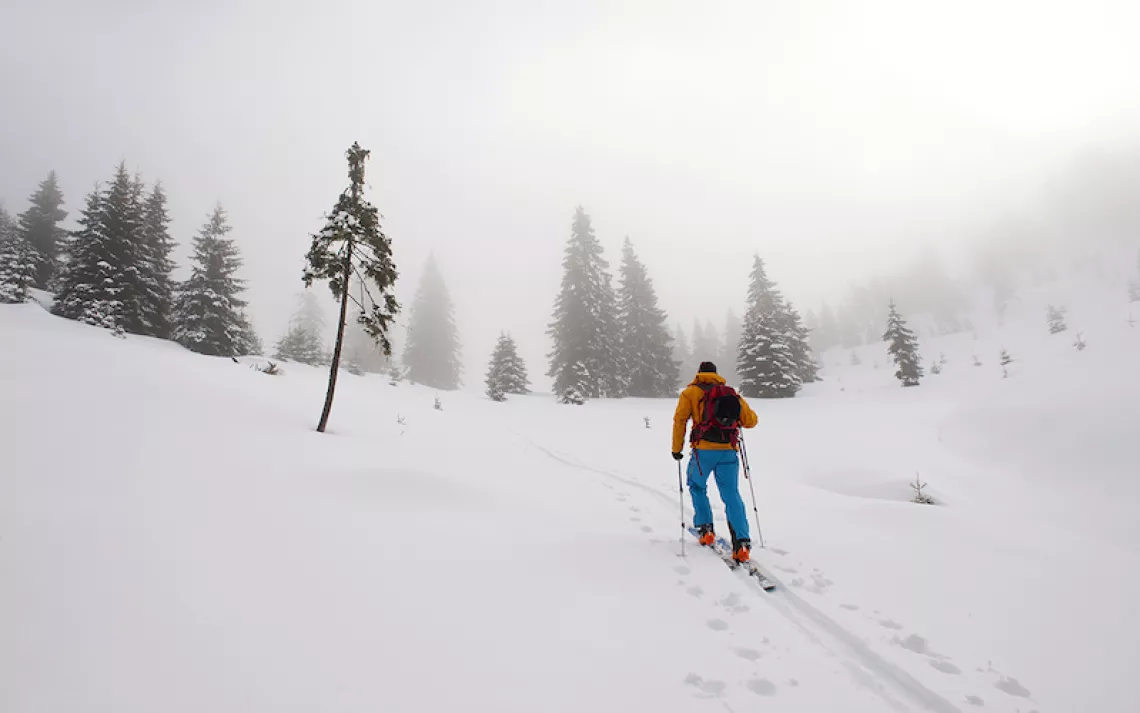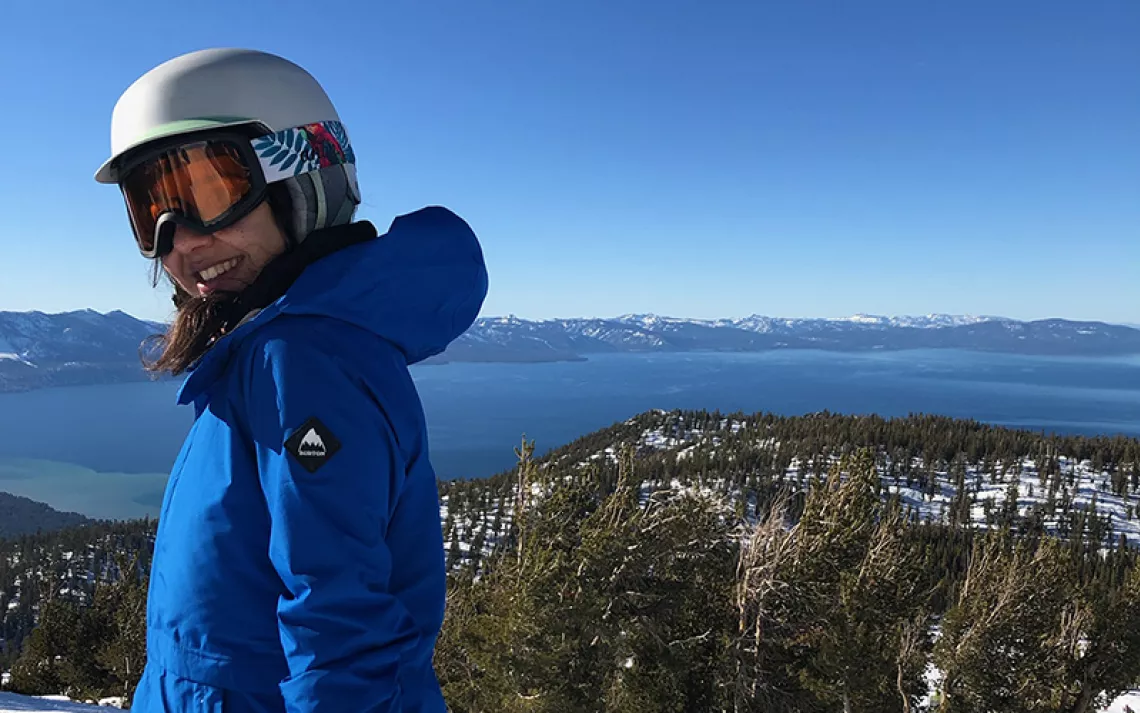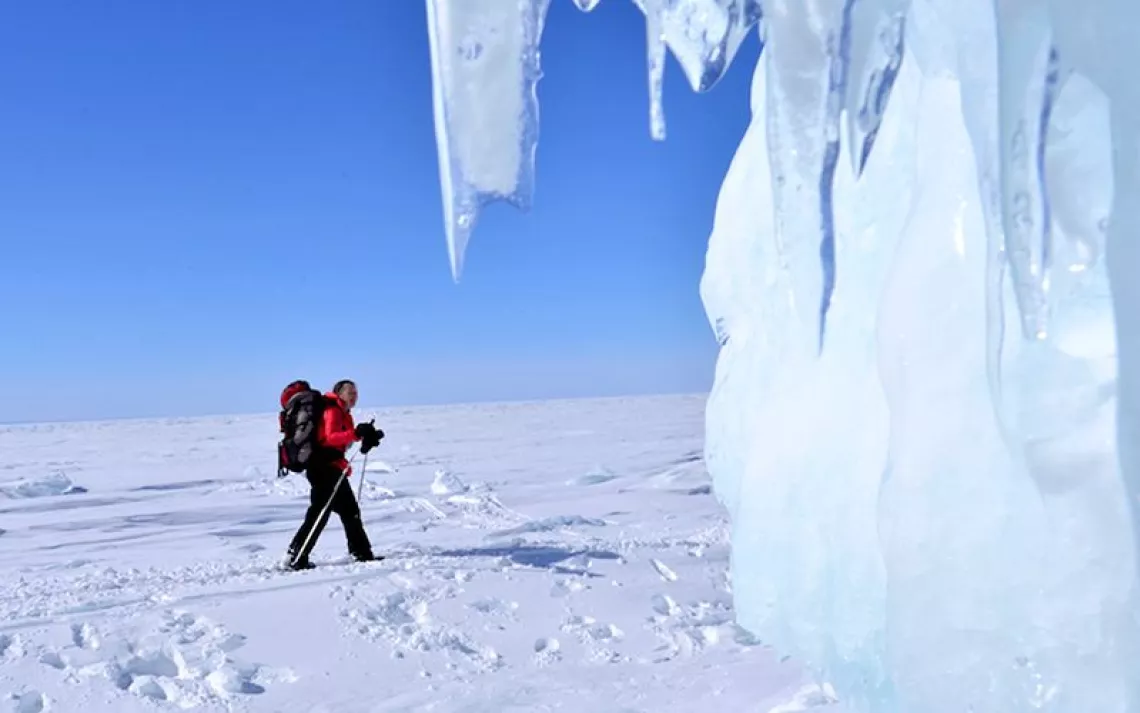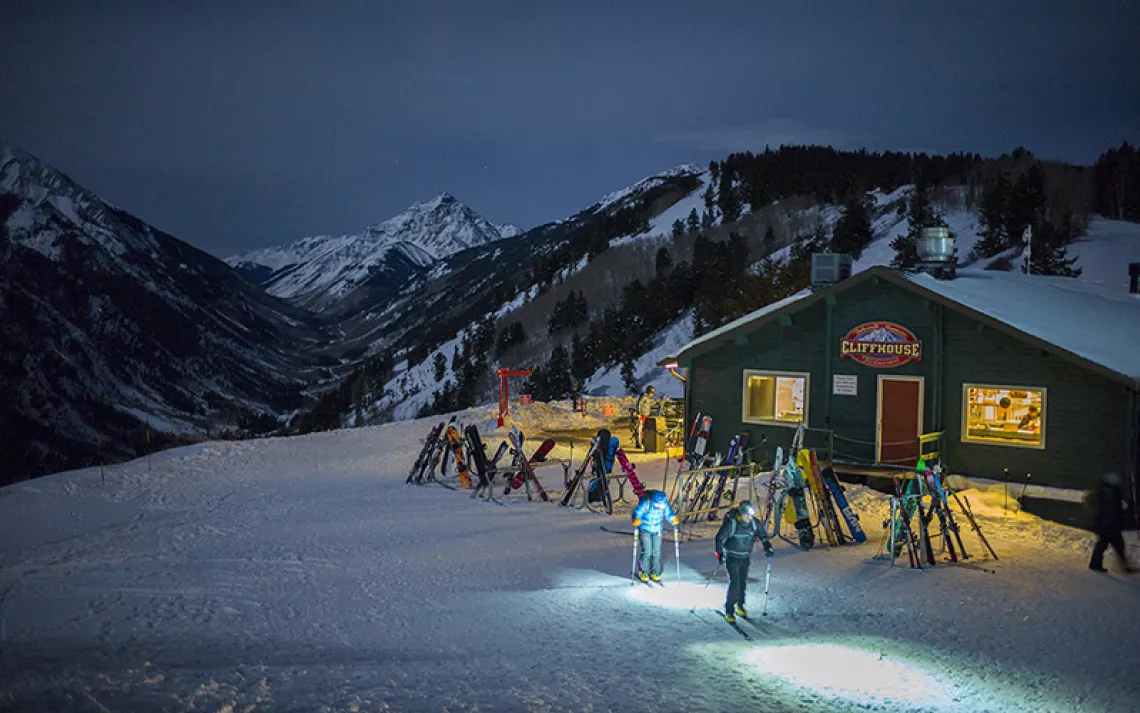8 Backcountry Skiing Adventures
Plus tips for skiing the unpatrolled slopes safely this winter
I’ve been skiing ungroomed, unpatrolled swaths of the Wyoming backcountry for more than 20 years, and I only vaguely remember what it was like to have the only car in the parking lot on top of Teton Pass on a storm day. Nowadays, lots that used to be only partially filled following a fresh foot of powder have lines of cars waiting even when there’s no new snow. The number of backcountry skiers and snowboarders is hard to pin down, but anecdotal evidence from the Tetons to Rogers Pass in British Columbia and Colorado’s Indian Peaks and Rocky Mountain National Park show that, whatever that number is, it’s on the upswing. And for good reason—the backcountry is a magical land where the powder is plentiful and deep, the vistas unsullied, and lift lines unknown.
But before you pursue any backcountry skiing on your own—without a professional guide—you should educate yourself on how to do so as safely as possible. According to the CAIC, Colorado Avalanche Information Center, 25 people in the US died in avalanches during the 2018–19 winter season; 18 of these were skiers, snowboarders, and snowshoers; the rest were snowmobilers. “It’s imperative to get avalanche training so you know when and where you can safely ski,” says Janelle Smiley, a Wyoming-based skiing and climbing guide. “The number one goal of any day in the backcountry is to come home at the end of it.”
Here are three ways to start learning the skills to safely ski in the backcountry. For when you’ve mastered the basics, I’ve also listed eight adventures—ranging from those that require the least experience to those you’ll want to tackle once you’ve developed some backcountry savoir-faire. Happy turns!
LEARN
* Guide services across the country offer AIARE (American Institute of Avalanche Research and Education) certified Avalanche Level 1 classes. These are three days in length and mix time in the classroom with time out in the field. Usually, the first day is in the classroom and the next two you’ll be outside on skis. By the completion of a Level 1 course, you’ll know the basics about tests to perform on the snowpack to determine its stability, route finding, and travel techniques in any terrain, plus companion rescue. You’ll also have an appreciation for how much there is to snow science and avalanche safety. Eastern Mountains Sports School (800-310-4504; 2686 White Mountain Highway, North Conway, NH; from $375/person) is the largest provider of avalanche training in the East and runs Level 1 courses all winter long. Sierra Mountain Center (760-873-8526; 200 South Main Street, Bishop, CA; from $425/person) meets at the White Mountain Research Station just outside of Bishop, California. Colorado Mountain Club (303-279-3080; members $470, nonmembers $515) offers Level 1 courses based out of Denver and Boulder.
* Jackson Hole Outdoor Leadership Institute offers at least two women’s-only Level 1 avalanche classes every winter. “I think women turn off the performance and can be more real when men aren’t around,” Smiley says. “And it’s usually a more playful and less intimidating environment.” (307-733-7425; Jackson Hole, WY; thanks to underwriting by the nonprofit organization SheJumps, which works to increase participation of girls and women in outdoor activities, tuition is only $399.)
* For those who learn well online, and for those who like to pre-prepare, IFGMA-certified guide Mark Smiley (husband to Janelle) recently launched a seven-hour online avalanche and mountaineering safety course that’s been three years in the making. “It’s not intended to take the place of an avalanche Level 1 or 2, or professional, class; it’s my opinion of the stuff that works in the field based on my years of experience,” Smiley says. “If you’re going to take your Level 1, this could warm you up to some of the ideas you’re going to learn in that class.” Also, it’s super convenient—no travel is required and you can go back over things as often as you want—and engaging: there are no boring PowerPoint presentations. Lively lectures are accompanied by demonstrative videos from the field. For those who have taken a Level 1 class but maybe don’t remember everything, this course makes for a great refresher. $245, mtnsense.com
ADVENTURE
* If you can afford it, one of the best intro-to-backcountry experiences is skiing out of a resort’s boundaries with a trained guide. When Jackson Hole Mountain Resort (JHMR) decided to open its boundary gates to skiers in 1999, it was among the first resorts in North America to do so. This is now the norm at ski resorts; still, the backcountry terrain adjacent to JHMR is among the best. Hire a local guide for a day-long tour of the skiing and riding terrain accessible from the resort. You can use the resort’s lifts and tram to do most of the uphill work for you, but expect some bootpacking. If you request it in advance, a guide might even be able to plan a route or two that requires skinning, or uphill skiing. 888-DEEP-SNOW; Teton Village, WY; $1,075 for a group of four
* Mountain Trip and Northeast Mountaineering guides show you the backcountry goods in Colorado’s San Juan Mountains and New England’s White Mountains, respectively. Both guide services cater objectives to your skill level, fitness, and interest. Since you’ll be well away from ski resorts, it’s not too much to hope you might get a summit all to yourself (and your guide). Mountain Trip: 888-797-7590; Telluride, CO; $449/person if there’s one person; $325/person for two people, $250/person for three people, $230/person for four people; Northeast Mountaineering: 978-799-3783, 1054 Pinkham Notch Rd., Glen, NH; 978-799-3783; $275 for one person, $175/person for two people.
* Hankin-Evelyn Backcountry Recreation Area, in the Bulkley Range outside Smithers, British Columbia. is the only backcountry “ski area” on the continent. There are no lifts, avalanche control work, or grooming, but volunteers cut 13 runs on about 9,300 acres that were set aside as a nonmotorized zone. And there’s also a cozy warming hut for day use and a former fire lookout that has been redone to accommodate overnight stays. You can hire a guide, but because local users are super friendly and all the uptracks start from the same trailhead, this is a better place than most to get tips and advice from—and maybe even tag along with—more experienced backcountry skiers you’ve just met. While Hankin-Evelyn is the only place in North America specifically developed for backcountry skiing, there are a couple of former ski resorts that function similarly. Outside of Estes Park, Colorado, Hidden Valley removed its ski lifts in 1991, but backcountry skiers today can still take advantage of the ski runs that were cut in the 1950s. In 2015, the Trust for Public Land and communities around Brownsville, Vermont, partnered to buy the Mt. Ascutney Ski Area, which operated from 1946 until 2010. There are plans to maybe put in a T-bar, but until then, the former ski area belongs to backcountry skiers. 800-542-6673 (Tourism Smithers), Bulkley-Nechako A, BC, Canada; for a guide check with Local Supply Co., 3852 First Ave. Smithers, localsupplyco.ca , 250-847-5388
* At Teton Pass, Wyoming, and Galena Summit, about 30 miles northwest of Ketchum, Idaho, your car can do a lot of the uphill work. The former offers opportunities for both bootpacking (up Mt. Glory on the north side of Wyoming Highway 22) and skinning (on the south side of the road) in the Bridger-Teton National Forest. From the latter, which is the highest paved road in the Northwest (Idaho State Highway 75, and 8,720-feet), skinning about 900 feet up a ridge from the parking area gets you to open glades and tree skiing in the Sawtooth National Forest. Ski right back to your car, or drop off the backside, from which you’ll have to skin back up to the top. The Bridger-Teton Avalanche Center and Sawtooth Avalanche Center, respectively, issue daily reports about the avalanche conditions in both areas.
* Adjacent to Yellowstone National Park and a dead-end town in winter (the road east from town, into Yellowstone, is closed between early November and late April), Cooke City, Montana, is in the Beartooth Mountains. These snaggly peaks are home to a consistently deep and reliable snowpack (and also several packs of wolves). Founded in 2011 by Ben Zavora, Beartooth Powder Guides has a 10-person cabin and a six-person yurt that make great bases for multiple days of backcountry ski adventures in the range. Zavora and friends built the Woody Creek Cabin from standing dead timber harvested from nearby; the cabin is tucked into trees at 8,700 feet and only accessible by skis or snowshoes. Hire a snowmobile to take you to the Mt. Zimmer Yurt, which is eight miles from the trailhead. At 9,500 feet near the Zimmer Creek Wilderness Boundary, the yurt allows day-long ski tours that range from tree skiing to summiting (and skiing) major mountains in the range, including Glacier, Fox, and Wolf Peaks. 406-838-2097; Cooke City, MT; fully guided trips with transportation to the cabin or yurt are $250/person/day for a group of four or six; kick up the cushy-ness factor by having your entire time in the yurt catered for another $75/person/day.
 The Magazine of The Sierra Club
The Magazine of The Sierra Club




